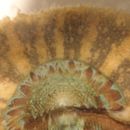Look Alikes
provided by Invertebrates of the Salish Sea
How to Distinguish from Similar Species: Mopalia ciliata and M. spectabilis have abundant girdle hairs up to 3-4 mm long. M. imporcata has hairs of length equal to or greater than the width of the girdle.
- license
- cc-by-nc-sa
- copyright
- Rosario Beach Marine Laboratory
Comprehensive Description
provided by Invertebrates of the Salish Sea
Biology/Natural History: This chiton is a generalist feeder which cleans almost everything off the rock areas on which it grazes.
- license
- cc-by-nc-sa
- copyright
- Rosario Beach Marine Laboratory
Habitat
provided by Invertebrates of the Salish Sea
Under rocks, in crevices, or under ledges
- license
- cc-by-nc-sa
- copyright
- Rosario Beach Marine Laboratory
Distribution
provided by Invertebrates of the Salish Sea
Geographical Range: Northern Alaska to southern California, rare south of Oregon
- license
- cc-by-nc-sa
- copyright
- Rosario Beach Marine Laboratory
Habitat
provided by Invertebrates of the Salish Sea
Depth Range: Mostly intertidal, to 18 m
- license
- cc-by-nc-sa
- copyright
- Rosario Beach Marine Laboratory
Comprehensive Description
provided by Invertebrates of the Salish Sea
This chiton has a girdle with thin, scattered, flexible hairs but it is not granular nor does it have overlapping scales. The girdle is of similar width all around and is not sharply wider anteriorly. The girdle hairs are shorter than the width of the girdle and so fine and scattered that at first it may appear that the girdle has no hairs. The girdle hairs have fine filaments which are often in two rows up opposite sides of the hair and are tipped by a glassy spicule. Body length is not more than twice the width. The posterior end has a distinct cleft. Plates 1 and 8 are of similar length. The central areas of most of plates 2-7 have longitudinal rows of tubercles plus pits. The lateral areas of plates 2-7 generally have oblique rows of tubercles. Where the central and lateral areas meet there is a ridge of fairly large tubercles which may be partly coalesced. The girdle is flesh or tan colored, sometimes with alternating lighter and darker stripes as seen above or mottled light/dark brown. Color of plates variable. Length up to 6 cm.
- license
- cc-by-nc-sa
- copyright
- Rosario Beach Marine Laboratory

